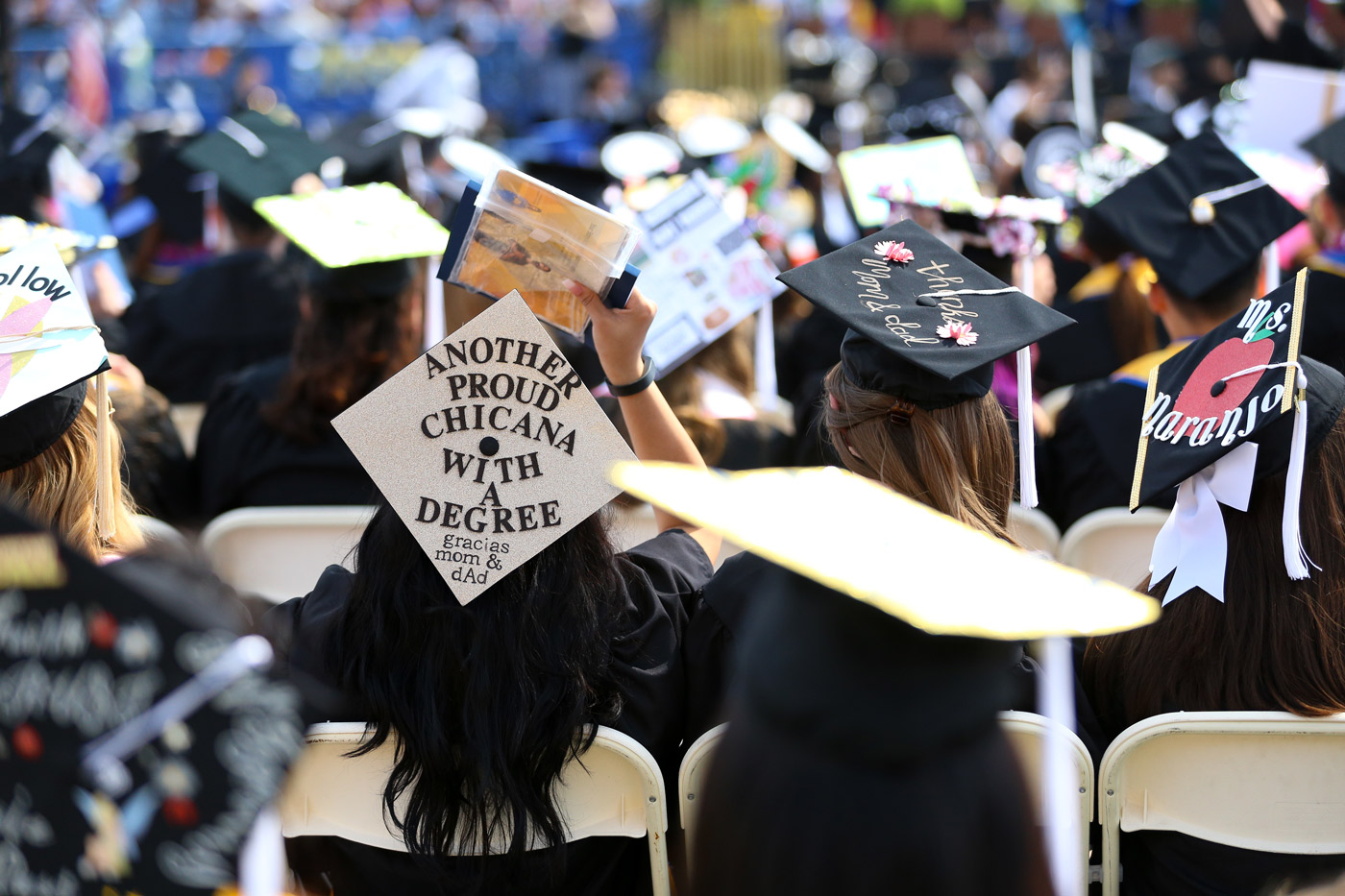
Photo: David Schmitz
Media contact:
Pat Lopes Harris, SJSU Media Relations, 408-924-1748, pat.harris@sjsu.edu
SAN JOSE, CA – San Jose State University concluded the year with its largest graduating class ever and a commencement speaker who pulled no punches while telling SJSU’s newest alumni that the fate of the nation rests on their shoulders.
More than 9,000 students received degrees this year, including approximately 2,000 engineering majors, 1,000 business majors, and thousands more majors in the arts and sciences.
They will enter the working world or begin coursework toward advanced degrees as colleges and universities nationwide continue to address campus unrest over race relations, equity and safety.
Harry Edwards

Photo: David Schmitz

Photo: Christina Olivas
There was perhaps no better time for alumnus Harry Edwards to return to serve as the commencement speaker on May 28 in Spartan Stadium. It was his first major address at SJSU since leaving campus in a cloud of controversy a half century ago.
Born and raised in the Midwest, Edwards came to California to attend college, arriving during the middle of the civil rights movement. He finished his degree, and then began a doctoral program at Cornell University while teaching at SJSU.
It was then that he became nationally known as the outspoken leader for the Olympic Project for Human Rights, which exposed the inequities experienced by black athletes representing the nation abroad while fettered by racism at home.
Edwards was a major influence on Tommie Smith and John Carlos, SJSU students and track and field stars who medaled at the 1968 Olympics. They leveraged their moment in the spotlight to take a stand for human rights, then were expelled from the Games and admonished by many, angered by the politicization of the international event.
Once known as a dangerous militant, this year’s commencement speaker is now recognized for his role in the civil rights movement.
“Harry Edwards is a renowned sociologist and author,” Interim President Susan Martin said, adding his contributions “represent the ideals of the California State University and San Jose State University.”
Tribute
Perhaps the most poignant moment of commencement came when Edwards rose to receive an honorary Doctorate of Humane Letters from the California State University.
CSU Trustee Steven Stepanek bestowed the honor, assisted by John York, co-chair of the San Francisco 49ers. York and Edwards appeared together, a rare glimpse into the personal nature of the relationship between the professor and the team.
In addition to serving as a teacher, author and father, Edwards carves out time to work with the 49ers, something he began back when desegregation of professional sports was fresh and new.
His role has been to help coaches and players from very different backgrounds work and grow together. He was especially close to the late Bill Walsh, the 49ers coach and fellow SJSU alumnus who took the team to three Super Bowls in the 1980s.
A note from Walsh to Edwards is among the items in a new collection at the Dr. Martin Luther King, Jr. Library. The video and prepared remarks from today’s speech are available online.
Speech

Photo: Christina Olivas

Photo: Christina Olivas
Edwards opened with a bit of humor, vowing to keep the speech short: “That’s an exceedingly high bar to achieve — especially for a sociologist!”
His messages were simple: “keep the faith,” “do not be afraid,” “continue the struggle.”
But his thoughts were rooted in the complex academic theories he spent a lifetime studying, discussing and practicing, especially what it means to live in a participatory democracy.
“The difference between a mob and a movement,” he said, “is that a movement not only organizes and mobilizes around an issue — it gets people out to vote!”
In these ways, he addressed the question on everyone’s mind — what can today’s activists learn from those of yesteryear? — while encouraging youths to confront and prevail over the greatest challenges of our time.
“One day,” he concluded, “someone standing at this very podium, overlooking some future graduating class, may well feel compelled to the judgement that you, members of the 2016 San Jose State University graduating class, were part of our ‘greatest generation.’”
Tradition
Edwards’ deep voice thundered through Spartan Stadium, midway through a ceremony steeped in tradition. Top graduates were recognized, beloved professors honored, a moment of silence held in memory of classmates who passed away.
One tradition that takes on extra meaning at SJSU is the moment when the president invites all the graduates to stand and thank family and friends for their support over the years.
Given that more than half of the graduates are the first in their families to earn college degrees, this never fails to bring forth sustained applause from the graduates on the field, and tears from their loved ones in the stands.
Of course there comes a point at any commencement when the graduates can’t hold back any longer, and today was no different. Once again, exuberance erupted as degrees were conferred, tassels moved from left to right, and beach balls appeared.
Congratulations, class of 2016!
See and share photos and messages from commencement with #SJSU16 on Facebook, Twitter and Instagram.
About San Jose State University
The founding campus of the 23-campus California State University system, San Jose State provides a comprehensive university education, granting bachelor’s, master’s and doctoral degrees in 145 areas of study with an additional 108 concentrations – offered through its eight colleges.
With more than 32,000 students and nearly 4,370 employees, San José State University continues to be an essential partner in the economic, cultural and social development of Silicon Valley and the state, annually contributing more than 7,000 graduates to the workforce.
The university is immensely proud of the accomplishments of its more than 220,000 alumni, 60 percent of whom live and work in the Bay Area.
